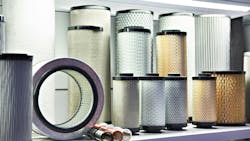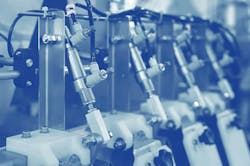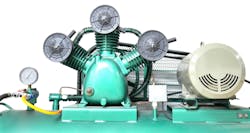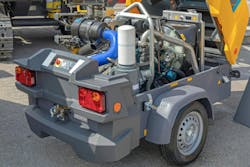Air Oil Separator Market to Grow 5.3% Over Next Decade
Research firm Fact.MR is forecasting the global air oil separator market to rise at a compound annual growth rate (CAGR) of 5.3% through 2034. In 2024 it is projected to reach a value of $2,065.5 million and by 2034 $3,461.9 million.
Air oil separators are an important component in compressed air systems as they separate oil from compressed air to protect machines and components. Separating the oil prevents it from entering piping and the pneumatic components typically powered by compressed air which would otherwise cause performance issues. In addition, it reduces the chance of potential contamination of items downstream such as food or sensitive electronics produced by the machine utilizing the compressed air system.
Manufacturing, automotive, oil & gas and aerospace are among the industries which are heavy users of compressed air systems and thus air oil separators. As such, anticipated growth in these sectors over the coming years will help drive growth for the air oil separator market as well.
The manufacturing industry, for instance, is currently forecast to grow 15% through 2028, providing opportunities for the many components and machines utilized in this sector. Growth in this market is projected to drive the global air compressor market as well which will again benefit the global air oil separator market.
Drivers for Air Oil Separator Market Growth
According to Fact.MR’s report on the global air oil separator market, there are a number of factors driving growth for this sector including investments in infrastructure development, industrialization and increasing awareness of environmental sustainability.
The research firm notes there are several emerging economies which are rapidly industrializing to meet global demand for an array of products. This is driving demand for machinery which uses compressed air systems and thus the need for air oil separators.
Separators will help to keep these machines performing as desired while also ensuring product quality. To extend the longevity of industrial machines and their production capabilities, it will be necessary to conduct routine maintenance and periodically replace air oil separators.
Like any other filter technology, separators eventually get to the end of their useful life and can no longer separate oil leading to the need to replace them which will benefit future market growth as well.
The highest levels of growth are anticipated in North America and East Asia, 4.8% and 5.4% respectively, due to investments being made in manufacturing and infrastructure in these regions.
Per Fact.MR’s report, the U.S. and Canada will be the key drivers for increasing air oil separator demand in North America over the coming years with the U.S. being the dominant player. The U.S. currently accounts for 72.4% of the market and is projected to hold 73.5% of the North American market share by 2034.
This is due in large part to the country’s manufacturing sector which is seeing new investments as companies look to create more localized production of goods to improve supply chains. Government investment through the Inflation Reduction Act and CHIPS and Science Act is aiding investments in domestic manufacturing as well.
READ MORE: How the CHIPS and Science Act Will Benefit Fluid Power and Motion Control Manufacturers
In addition, there are many infrastructure investments being made in the U.S. aided by the Infrastructure Investment and Jobs Act which passed in 2021. It provides funding for the repair and building of roads, bridges and other critical infrastructure to improve the transport of people and goods. Compressed air systems are often used during the construction of these to power pneumatic tools or other applications.
Within the East Asian market, China will be the key driver for air oil separator demand. The country accounts for 56.9% of the market currently which will grow to 57.3% by 2034. Fact.MR said in its report that increased industrialization in industries such as manufacturing, automotive, electronics and heavy machinery will drive demand for compressed air systems over the coming years and thus oil separators as well.
Similar to the U.S., government policies aimed at promoting industrial development and modernizing infrastructure are a large driving factor for this growth.
Sustainability a Potential Pro and Con for Air Oil Separators
Greater importance and awareness of sustainability around the world could provide both opportunities and challenges for the air oil separator market according to Fact.MR’s report.
Various environmental regulations are driving a need for technologies which have less of an impact on the environment while at the same time people and companies want to do their part to reduce waste and emissions.
The ability of separators to remove oil from compressed air is beneficial to sustainability efforts as it keeps oil from entering the environment and enables its reuse in the air compressor for lubrication. In addition, more efficient options have entered the market to help minimize energy consumption, and thus emissions, for customers.
However, Fact.MR said development of more energy efficient separators could also pose challenges for the market. Continually developing new separator technology that is efficient but does not hinder performance while also being cost-effective takes time and money. Air oil separator manufacturers may not have the resources to keep up with these new technology needs.
There are of course several separator manufacturers making such investments because they understand more efficient products will benefit customers and the environment, and there is demand for them given the increasing desire of many to be more sustainable.
READ MORE: Filters Play Important Part in Compressed Air System Efficiency
Another potential challenge for the air oil separator market is the growing popularity of oil-free air compressors due in part to the environmental benefits they can provide. These compressors do not use oil as a lubricant for their internal components which reduces the chances of oil making its way into the compressed airstream and thus the need for a separator.
Robert Horneman, Product Manager at ELGi Industrial – a developer of air compressors – said in an interview with Power & Motion that eliminating the use oil in compressors can help companies’ sustainability goals. The lack of oil in these compressors prevents potential contamination issues as well as waste from replacing the several filters typically used in an oil-lubricated compressor.
Watch our interview below with Honeman to learn more about oil-free air compressors.
Although use of oil-free air compressors is increasing, Fact.MR said in its report the oil-lubricated compressor segment is projected to account for a large share, 52.9%, of the global air compressor market through 2034.
Despite some of the potential challenges, continued demand for compressed air systems in various industries will keep the air oil separator market on a positive trajectory for the next decade.
About the Author
Sara Jensen
Executive Editor, Power & Motion
Sara Jensen is executive editor of Power & Motion, directing expanded coverage into the modern fluid power space, as well as mechatronic and smart technologies. She has over 15 years of publishing experience. Prior to Power & Motion she spent 11 years with a trade publication for engineers of heavy-duty equipment, the last 3 of which were as the editor and brand lead. Over the course of her time in the B2B industry, Sara has gained an extensive knowledge of various heavy-duty equipment industries — including construction, agriculture, mining and on-road trucks —along with the systems and market trends which impact them such as fluid power and electronic motion control technologies.
You can follow Sara and Power & Motion via the following social media handles:
X (formerly Twitter): @TechnlgyEditor and @PowerMotionTech
LinkedIn: @SaraJensen and @Power&Motion
Facebook: @PowerMotionTech

Leaders relevant to this article:




